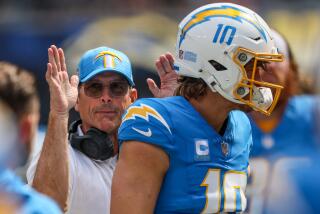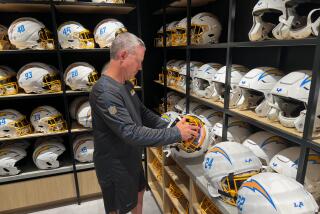Next Historic Catch by Largent Gives Him Pass at Don Hutson : Pro football: Seattle wide receiver is one touchdown reception away from NFL record.
- Share via
SAN DIEGO — It’s the triple crown of pass receiving, and a most unlikely candidate is on the verge of winning it.
Ring Lardner, a legendary New York sportswriter with a remarkable flair for humor, had a pet line that would have been a perfect fit for Steve Largent: “Although he was small, he was also slow.”
Largent is so small and so slow that 116 players were picked ahead of him in the National Football League’s 1976 draft. He is so small and so slow that, after taking him in the fourth round, the Houston Oilers considered themselves lucky to get an eighth-round choice from the Seattle Seahawks when they decided to cut him.
All Largent can do is catch every pass thrown near him, and he has done that so often in the last 14 seasons that he is closing in on one of the greatest achievements in the history of football.
Largent already has won two legs of the pass receivers’ triple crown, in each case taking records away from Charlie Joiner, formerly of the San Diego Chargers. Largent has caught 792 passes and amassed 13,709 yards.
Now Largent is poised to complete the grand slam by breaking Hall of Famer Don Hutson’s record of 99 touchdown pass receptions. He has 98.
Largent caught two passes for 32 yards in his return to the Seattle lineup Sunday against the Chargers in Seattle after missing six games with a broken bone in his right elbow. But neither of those was a scoring pass, so he will have to wait at least until next Sunday, when the Seahawks play at Kansas City.
Largent, 35 a month ago, has announced that this will be his final season, so there is a sense of urgency about scoring the two touchdowns he needs to reach 100. Still, he doesn’t think the full impact of such an achievement will hit him until he has retired.
“I think I’ll be more emotional about it later on,” Largent said from Seattle. “When I’m on the field, I get so caught up in the game and the team aspect of it that I don’t feel the true perspective on the whole thing.
“That was crystallized for me when I was out for six weeks. Being out of the game, I was able to step back and get a broader view.”
That is not to say that the significance of the record within his grasp has been lost on the University of Tulsa alumnus. The record is one of the oldest on the NFL books, having stood 44 years, and is held by the man generally considered the greatest receiver of all time.
Hutson, 76, who lives in retirement in Rancho Mirage, was an All-American end opposite the late Paul (Bear) Bryant at Alabama in 1934. Bryant went into coaching and Hutson joined the Green Bay Packers. From 1935 through 1945, there wasn’t a man in the league who could stop him.
Hutson was the first player to achieve receiving’s triple crown, and still stands as the only one. When he retired with 488 catches, the runner-up was 298 behind him.
In 11 pro seasons, Hutson led the league in catches eight times, in reception yardage six times and in touchdown passes nine times. He also intercepted 30 passes as a safety--players went 60 minutes in those days--and even kicked extra points and field goals. All told, he scored 823 points, including 105 touchdowns.
“I haven’t really studied Hutson, but I’ve heard about him,” Largent said. “I haven’t heard one negative comment about him. I’ve heard he was a great player, and most of all, a great person.”
Largent also has the utmost respect--in this case the knowledge being firsthand--for Joiner, who coaches the Charger receivers. He broke Joiner’s records of 750 catches in 1987 and 12,146 yards in 1988.
“I really admired Charlie,” Largent said. “He was a gifted athlete, but he worked hard, too. I remember a quote by Earl Weaver: ‘The most important thing is what you learn after you think you know it all.’ Joiner is that type of person.”
Hutson was far ahead of his time. It is said that he invented many of the moves that wide receivers use today.
The late Charlie Brock, a Packer center for the last seven of Hutson’s 11 seasons, once said, “Hutson revolutionized pass receiving. Of all the players from our era, the one most likely to be able to play today would be Hutson. He faked linebackers right onto their backs, and he could stop and go so quickly that the defenders were always off balance. There was nobody close to him.”
True, Hutson made his moves against players who were not the specialists that defensive backs are today. Because free substitution was still in the future, they spent half their time playing offense.
Even so, there are those who insist that that technicality didn’t make any difference. One is another Packer Hall of Famer, halfback Paul Hornung of the late Vince Lombardi’s glory teams of the ‘60s.
One time, Hornung and several teammates were watching old Packer films and saw Hutson shake off triple coverage to catch a pass.
“I’m a believer,” Hornung said. “Am I a believer! You know what Hutson would do in this league today? The same things he did when he played.”
Hutson was two inches taller than Largent at 6-1 but 10 pounds lighter at 180. He also was considerably faster.
In an interview in 1986, Hutson compared his style and the players of his era with those of today.
“I would say that the receivers today use pretty much the same moves that we had,” Hutson said. “There’s no question that we started a lot of that stuff. Understand that I have the greatest respect in the world for the players of today. They’re far better at everything than we were in the old days. They’re such specialists at their positions.”
Largent’s coach, Chuck Knox, recalled reading and hearing about Hutson’s exploits in his grade school days in Sewickley, Pa.
“I was aware of Hutson as a kid growing up,” Knox said. “From what I’ve heard since, he was a great receiver and a competitor, a complete football player, a team guy. He had speed, ability, good hands and the toughness to go with it.”
Asked about the belief that Hutson pioneered the art of receiving, Knox said, “I think that’s true.”
And Largent? Mention his name and the normally reserved Knox searches for superlatives.
“Steve is a unique player, a unique person,” Knox said. “He epitomizes what people mean when they talk about professional athletes as role models.
“He watches everything that goes on in practice, he studies at night, and he’s productive every Sunday. That’s why he’ll be in the Hall of Fame.”
Knox noted how diligently Largent worked during the rehabilitation period that followed his opening-game injury.
“He went out on the field by himself and ran all the pass patterns,” Knox said. “He even put pads on. You just don’t see players on injured reserve with pads on, but Steve is a different type of person.
“I’ve seen only two players in my 36 years in coaching work that hard in rehab. The other was Merlin Olsen, and he’s in the Hall of Fame.”
Told of Knox’s remarks, Largent said, “There was method to my madness. I wanted to come off IR and be back in midseason form. Staying used to wearing pads and a helmet, seeing the football and running routes were things I could do while I was on IR. I caught one-handed after a couple of weeks, and within four weeks I was catching normally.”
Largent said he hadn’t patterned his style after any one receiver.
“I watch the others and the things they do,” he said. “If I see a good route that’s new to me, I may use it. I try to borrow from a lot of different players.”
One thing Largent doesn’t have to borrow is class. He is a man of intense compassion, and he was greatly saddened when Jim Zorn lost the quarterback job to Dave Krieg in 1983.
“Jim and I established rapport very quickly,” Largent said. “We had a lot of things in common, and we were very close. Dave and I have good rapport, too, but it’s tough to see one of your friends lose his position.”
Zorn, who started 100 games for the Seahawks before being released in 1984, coaches the quarterbacks at Boise State.
At this point, Largent holds five NFL records. Besides those for receptions and yardage, he has records of 10 seasons with 50 or more catches, eight seasons of 1,000 or more yards and a current streak of 169 games with at least one catch.
Which record means the most to him?
“The one for career receptions,” he said. “That’s the one everybody looks at. The ultimate would be to get the reception, yardage and touchdown records, but I haven’t broken the third one yet.”
Although Largent hasn’t shown any signs of going downhill--his average yardage per catch of 16.5 last season tied the third best of his career--he is adamant about retiring at the end of the season.
“It will be hard to leave, but I’ve got to move on,” he said. “Coaching is not in my future because I wouldn’t enjoy being forced to move my family all over the country. I have business interests in Tulsa and Seattle, and I’ve talked to a couple of network people about doing TV work after my career is over. At this point, I don’t have any particular direction.”
As Knox noted, one direction Largent is sure to take is toward the Hall of Fame, and he was asked if he had given this much thought.
“That’s a difficult question to answer,” he said. “It presumes so much, and I just don’t want to do that. But it brings a smile to my face every time I look in the record book and see my name with the likes of Hutson and Lance Alworth and Raymond Berry, some of the fabled receivers of the NFL.
“It’s all like a dream to me. I can’t believe it’s true.”
More to Read
Go beyond the scoreboard
Get the latest on L.A.'s teams in the daily Sports Report newsletter.
You may occasionally receive promotional content from the Los Angeles Times.










